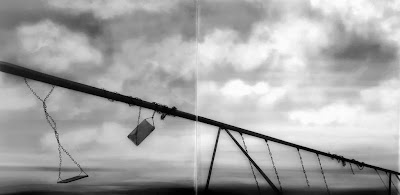 |
| Erwin Blumenfeld, The Picasso Girl, 1941-42 |
So many fashion photographers end up selling their creative
soul to the jaws of commercial demands, sacrificing all trace of
experimentation to meet the needs of advertising the client and to feed the
bank balance. Not Erwin Blumenfeld. Until the very end of his career, he was
able to incorporate creative flair into otherwise generic advertising
images, Vogue and Harper’s Bazaar’s covers, as well as the
films he made for the Dayton department store in Minneapolis. The current
exhibition of his work at the Jeu de Paume shows a lifetime of Blumenfeld’s
work, an oeuvre that is always looking and searching for the vanguard of
photography. In fact, some might even argue that the fashion photography is
among his most exciting work.
 |
| Erwin Blumenfeld, Self-Portrait, 1945 |
The exhibition is curated by a leading scholar of modern
German photography, Ute Eskildsen of the Museum Folkwang in Essen. The
sophistication of Eskildsen’s knowledge of the period in which Blumenfeld was
working, together with her experience as a curator, shows in what is a revellatory hanging of his work. The photographs are organized generically, moving from the
pre-photographic montages and drawings, through portraiture, nudes,
architecture to fashion. Thus, rather than following chronological development,
we are witness to how different subject matter enables Blumenfeld to bring out
the singularity of what was, at the time, this relatively new medium of
photography.
 |
| Erwin Blumenfeld, Three Profiles, 1952 |
From the beginning Blumenfeld experiments. He explores
light, reflections through the use of mirrors, shadows, darkness, always
intensifying the schism between the positive and negative of a photographic
image. In some works, he moves far beyond chiaroscuro to blackening out the
entire ground, until in 1952, the face in profile is reduced to an outline of
coloured light. In Three Profiles,
the negative and positive photographic print cannot be distinguished, the two
are here brought together. This theme of
the negative and positive, inside and outside, opposites in a single image – is
extended beyond the formal to the complexity of the person in the portraits.
From the beginning Blumenfeld finds the female form in the male body, the inanimate
in the human, the grotesque in the beautiful. Blumenfeld achieves this through
overlaying multiple negatives, combining different elements in the darkroom,
thus creating a montage in the process of photographic production.
 |
| Erwin Blumenfeld, Voile Mouillé, 1937 |
Blumenfeld is truly interested in the female form: it’s not an academic
exercise. And all of the screening and masking, the various techniques and
ruses of composition used to hide or complicate the form, serve to emphasize
the form of the figure and depose the identity of the sitter. When he comes to
photograph buildings, they resemble the portraits. That is to say, the light is
magnificent in its use to bring out the form and structure. Again he uses
double exposures, and manipulations of light to abstract the buildings to convince us that form is itself an artistic creation, just as if it were the female
body.The final fashion photographs are sumptuous. We see Blumenfeld’s
fascination with light transform into a dexterity with colour. He maintains the
use of mirrors, privileges over and under exposure, to create figures that are
spectres of their selves, or fragmented by a camera that replicates them
without original.
 |
| Erwin Blumenfeld, Hitler with Bleeding Eyes and Mouth, c. 1953 |
Throughout the exhibition I felt Blumenfeld’s photographs
always to be disturbing. In the early collages he includes images of soldiers,
and other icons of war, even if fragmented, as a way to protest the violent
ripping apart of his country and his people. And in response to National
Socialism, he made an images of Hitler with
bleeding eyes, and another of a skull superimposed on a portrait in what are
now darkly prophetic images. Everywhere in Blumenfeld’s images there are
distortions, double exposures, superimpositions, uses of light and mirrors to
create screens, fractures. And then there are broken images, like Broken Mirror Nude, 1947. The text says
that these works are playful and clever but for me, they are filled with trauma
and a sense of being eternally fragmented. It’s difficult not to read the
images as somehow reflective of Blumenfeld’s broken biography. As a German Jew
he was literally hunted from one country to another, always trying to get away
from the Nazis until he reached New York towards the end of the war. Without
detracting from the intelligence and creative innovation of these photographs,
the violence and drama appears to extend way beyond the technical and formal
levels. To me all of these photographs, but particularly the portraits, tell
the story of someone who carried the troubling scars of anti-Semitic persecution throughout his life.


.png)






